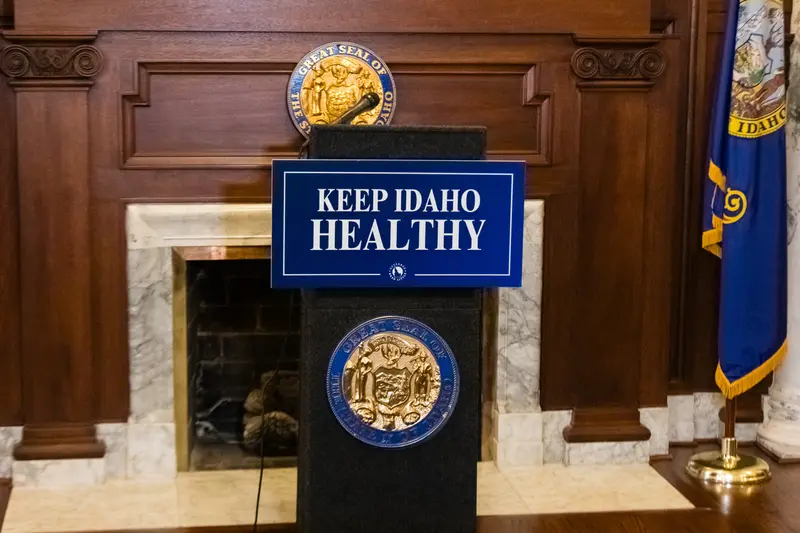ProPublica is a nonprofit newsroom that investigates abuses of power. Sign up for Dispatches, a newsletter that spotlights wrongdoing around the country, to receive our stories in your inbox every week.
Idaho
University of Idaho proposal to acquire University of Phoenix is approved by Idaho Board of Education

BOISE, Idaho — The Idaho State Board of Education approved the University of Idaho’s proposal to create a not-for-profit organization to acquire the University of Phoenix.
By creating the not-for-profit, called NewU, the University will be able to acquire all of the University of Phoenix’s assets, which includes its online education infrastructure.
The deal, which has been in the works since the early spring would see the two schools remain separate institutions, but able to share resources.
The proposal says NewU Inc. will acquire the University of Phoenix for $550 million, which will be paid for by bonds, separate from the University of Idaho’s funding.
Jodi Walker, the Executive Director of Communications at the University of Idaho, tells Idaho News 6 the online learning capability is a big part of the deal.
“The online platform and the online student success system can be iterated,” Walker said. “We can use that same platform, we can use that same technology, we can use those same skills, and things that they’ve developed over many years and apply those to our University of Idaho Students as well.”
The school and the board of education say expanding online learning for the University of Idaho will serve many adult students and students who don’t have the capability to move for a degree.
Multiple board members brought up the University of Phoenix’s history of misleading students. Back in 2021, the school had to pay out $50 million to almost 150,000 students in a class action for deceptive advertising.
When asked about how the Idaho Board of Education felt confident about the partnership given the school’s history, board president Linda Clark said they feel confident in the school’s new leadership.
“They’re under a new structure and I believe the current University of Phoenix staff, administration are very enthusiastic about becoming a not-for-profit public institution,” Clark said. “Many of the challenges that they had in the past could be found in the fact that they were a private for-profit institution.”
The acquisition is far from being final, but the first step of board approval is now behind the University of Idaho. The school says the deal likely won’t be complete until at least the start of 2024.

Continue Reading
Idaho
Idaho Banned Vaccine Mandates. Activists Want to Make It a Model for the Country.

Three women become choked up as they deliver news in a video posted to social media. “We did it, everybody,” says Leslie Manookian, the woman in the middle. She is a driving force in a campaign that has chipped away at the foundations of modern public health in Idaho. The group had just gotten lawmakers to pass what she called the first true “medical freedom” bill in the nation. “It’s literally landmark,” Manookian said. “It is changing everything.”
With Manookian in the video are two of her allies, the leaders of Health Freedom Idaho. It was April 4, hours after the governor signed the Idaho Medical Freedom Act into law.
The act makes it illegal for state and local governments, private businesses, employers, schools and daycares to require anyone to take a vaccine or receive any other “medical intervention.”
Whether the law will actually alter day-to-day life in Idaho is an open question, because Idaho already made it easy to get around the few existing vaccination requirements.
But it could have a significant effect in other states, where rules aren’t already so relaxed. And it comes at a time when diseases once eradicated from the U.S. through vaccination are making a resurgence.
The law runs against one of the hallmarks of modern public health: that a person’s full participation in society depends on their willingness to follow certain rules. (Want to send your child to public school? They’ll need a measles vaccine. Want to work in a retirement community during flu season? You might have to wear a mask.)
The new Idaho law flips that on its head. It not only removes the obligation to follow such rules, it makes the rules themselves illegal.
The new law sets Idaho apart from even conservative-leaning South Carolina, where two schools recently quarantined more than 150 unvaccinated children after measles arrived.
A person can spread measles for four days before symptoms appear. During the South Carolina schools’ quarantine, five students began to show symptoms, but the quarantine kept them from spreading it, the health department said this month.
That precaution would now be illegal in Idaho.
Idaho’s law caught the attention of people who share Manookian’s belief that — contrary to hundreds of years of public health evidence and rigorous regulation in the U.S. — vaccines are worse than the diseases they prevent.
It also caught the attention of people like Jennifer Herricks, a pro-vaccine advocate in Louisiana and advocacy director for American Families for Vaccines.
Herricks and her counterparts in other states say that vaccine requirements have “done so much good for our kids and for our communities.”
An analysis published last year by the U.S. Centers for Disease Control and Prevention found that routine childhood vaccines prevented more than 1.1 million deaths and 32 million hospitalizations in the U.S. over three decades, saving $540 billion in direct costs and saving society about $2.7 trillion. The analysis was limited; it didn’t account for the lives and money saved by vaccines for flu or RSV, which kill and hospitalize babies and children each year.
Idaho’s move was “pretty concerning,” Herricks said, “especially seeing the direction that everything is headed at the federal government.”
The law is the culmination of a decade of anti-vaccine activism that got a boost from the pandemic.
It’s rooted in a belief system that distrusts institutions — government health agencies, vaccine makers, medical societies and others — on the premise that those institutions seek only money and control.
Manookian said in an interview that she believes one person should never be told to risk their health in “the theoretical” service of another.
Now, Manookian and her allies have a new goal in their sights: to make Idaho’s legislation a nationwide standard.
Idaho was already more permissive than other states when it came to vaccine rules. Parents since at least the 1990s could send unvaccinated children to school if they signed a form saying vaccination went against their religious or personal beliefs.
That wasn’t good enough for Idahoans who describe themselves as advocates for health freedom. They worked to shift the paradigm, bit by bit, so that it can be easier now for parents to get a vaccine exemption than to show the school their child is actually vaccinated.
In recent years, lawmakers ordered schools and daycare centers to tell parents about the exemptions allowed in Idaho whenever they communicate about immunizations.
The state also decided to let parents exempt their kids by writing a note, instead of having to fill out a form — one that, in the past, required them to acknowledge the risks of going unvaccinated.
(There is conflicting data on whether these changes truly affected vaccination rates or just led more parents to skip the trouble of handing in vaccine records. Starting in 2021, Idaho schools reported a steady drop in the share of kindergartners with documented vaccinations. Phone surveys of parents, by contrast, showed vaccination rates have been largely unchanged.)
An enduring backlash against Idaho’s short-lived COVID-19 mandates gave Manookian’s movement more momentum, culminating this year in what she considered the ultimate step in Idaho’s evolution.
Manookian had a previous career in finance in New York and London. She transitioned to work as a homeopath and advocate, ultimately returning to her home state of Idaho.
The bill she came up with said that almost nobody can be required to have a vaccine or take any test or medical procedure or treatment in order to go to school, get a job or go about life how they’d like to. In practice, that would mean schools couldn’t send unvaccinated kids home, even during a measles outbreak, and private businesses and daycares couldn’t require people on their property to follow public health guidance.
The state had just passed “the Coronavirus Stop Act” in 2023, which banned nearly all COVID-19 vaccine requirements. If lawmakers did that for COVID-19, Manookian reasoned, they could do the same for all communicable diseases and all medical decisions.
Credit:
Courtesy of Leslie Manookian
Her theory was right, ultimately.
The bill she penned in the summer of 2024 made it through the Republican-controlled House and Senate in early 2025.
Manookian took to social media to rally support for the legislation as it sat on the desk of Gov. Brad Little.
But the governor vetoed it. In a letter, he explained that he saw the bill as government intrusion on “parents’ freedom to ensure their children stay healthy.” During an outbreak, he said, schools wouldn’t be able to send home students “with highly contagious conditions” like measles.
Manookian tried again days after the veto. In the next version of the bill, protections during a disease outbreak applied only to “healthy” people.
This time, Little signed it.
Weeks after the signing, Manookian joined like-minded advocates on a stage in Washington, D.C., for a launch event for the MAHA Institute, a group with strong ties to Robert F. Kennedy Jr. (MAHA stands for Make America Healthy Again.) The new Health and Human Services secretary had denounced vaccines for years before President Donald Trump appointed him.
At the gathering, Manookian announced her next mission: to make it “a societal norm and to codify it in law” that nobody can dictate any other person’s medical choices.
“We’re going to roll that out to other states, and we’re going to make America free again,” Manookian told the audience in May.
Manookian’s commitment to bring along the rest of the country has continued ever since.

Credit:
Screenshot by ProPublica
Her nonprofit, the Health Freedom Defense Fund, is now distributing model legislation and a how-to guide, with talking points to persuade legislators. Manookian said in podcast interviews that she is working with the nonprofit Stand For Health Freedom to mobilize activists in every state.
In an interview with ProPublica, Manookian said her objective is for people to “understand and appreciate that the most basic and fundamental of human rights is the right to direct our own medical treatment — and to codify that in law in every state. Breaking that barrier in Idaho proves that it can be done, that Americans understand the importance of this, and the humanity of it, and that it should be done in other states.”
Her efforts were rewarded over the summer with a visit from none other than Kennedy, who visited Boise and toured a farm with Manookian and state lawmakers in tow.
“This state, more than any other state in the country” aligns with the MAHA campaign, Kennedy told reporters at a news conference where no one was allowed to ask questions. Kennedy called Idaho “the home of medical freedom.”
The Department of Health and Human Services did not respond to ProPublica’s request for comment from Kennedy or his staff on Idaho’s law and his visit to the state.
Children’s Health Defense, the organization Kennedy built into one of the fiercest foes of childhood vaccines, took interest in the Idaho bill early on.
The group promoted the bill as it sat on the governor’s desk, as he vetoed it, then as Manookian worked successfully to get a revived bill through the statehouse and signed into law.
The organization’s online video programming featured Manookian five times in late March and early April. One show’s host told viewers they could follow Idaho in its “very smart strategy” of taking a law against COVID-related mandates, “crossing out ‘COVID,’ making a few other tweaks, and you have an incredible health freedom bill after that.”
Children’s Health Defense CEO Mary Holland said she’s known Manookian for more than 15 years and pushed the national organization to publicize Manookian’s work. Holland introduced her at the Washington, D.C., event.
Whereas most states put the onus on unvaccinated people to show why they should opt out of a mandate, Idaho’s legislation made unvaccinated people the norm — shifting the burden of accommodation onto those who support vaccination.
Now, parents of infants too young for a measles vaccine can’t choose a daycare that requires immunization. Parents of immune-compromised students must decide whether to keep their children home from school during an outbreak of vaccine-preventable diseases, knowing unvaccinated children won’t be quarantined.
Holland said Idaho parents who want their kids to be in a learning environment with “herd immunity” levels of measles vaccination can start a private “association” — not a school, because schools can’t require vaccines — just as parents who don’t like vaccines have done in order to dodge requirements imposed by states like California and New York.
“I think you could certainly do that in Idaho.” Holland said. “It wouldn’t be a public school. It might be the Church of Vaccinia school.”

Credit:
Otto Kitsinger for ProPublica
The day Idaho’s Medical Freedom Act was signed, a legislator in Louisiana brought forward the Louisiana Medical Freedom Act. In a hearing later, she pointed to Idaho as a model.
Louisiana followed Idaho once before in 2024, when it passed a law that requires schools to describe the exemptions available to parents whenever they communicate about immunizations. Idaho had passed an almost identical law three years earlier.
Herricks, the Louisiana pro-vaccine advocate, said she watched the Idaho Medical Freedom Act’s progress with “a lot of concern, seeing how much progress it was making.” Now it’s set a precedent, Herricks said.
Holland, the Children’s Health Defense CEO, said she looks forward to Idaho’s approach spreading.
She pointed to a September announcement by Florida Surgeon General Dr. Joseph Ladapo that he intends to rid his state of all vaccine mandates. Holland said she expects other Republican-controlled states to take a serious look at the Idaho law. (Ladapo’s office did not respond to requests for comment.)
“It’s a big change,” Holland said. “It’s not just related to vaccines. It’s a blow against the notion that there can be compulsory medicine.”
Some people support the more-than-century-old notion that compelling people to be vaccinated or masked will provide such enormous collective benefits that it outweighs any inconvenience or small incursion on personal liberty.
Others, like Holland and Manookian, do not.
At the heart of laws like Idaho’s is a sense of, “‘I’m going to do what I want to do for myself, and I don’t want anybody telling me what to do,’ which is in direct contrast to public health,” said Paul Offit, pediatrician and vaccinologist at the University of Pennsylvania and Children’s Hospital of Philadelphia.
Offit, who co-invented a vaccine against rotavirus, is a critic of Kennedy and was removed from a federal vaccine panel in September.
A more fundamental conflict is that some people believe vaccines and other tools to prevent the spread of illness, like masks, are harmful. That belief is at odds with the overwhelming consensus of scientists and health experts, including Kennedy’s own Department of Health and Human Services and the CDC.
Both tensions are at play in Idaho.

Credit:
Otto Kitsinger for ProPublica
As is the case nationally, Idaho’s “health freedom” movement has long pushed back against being labeled “anti-vaccine.” Idaho lawmakers and advocates have stressed that their goals are bodily autonomy and informed choice.
They do not take a stance on the bodily autonomy principle when it comes to abortion, however. Almost all state legislators who voted for the Idaho Medical Freedom Act also voted to ban abortion, if they were in office at both times.
“Every action has to be evaluated on its individual morality,” not on whether it does the most good for the most people, Manookian said.
But Manookian’s rejection of vaccine mandates goes beyond a libertarian philosophy.
Manookian has said publicly that she thinks vaccines are “poison for profit,” that continuing to let daycares require vaccination would “put our children on the chopping block,” that measles is “positive for the body,” that the virus protects against cancer, and that it can send people “into total remission” — an assertion she made on an Idaho wellness center’s podcast in April.
Manookian told ProPublica she believes infectious diseases have been made “the bogeyman.”
Against those claims, research has shown that having the measles suppresses immunity to other diseases, a phenomenon dubbed “immune amnesia” that can make children who have recovered from measles more susceptible to pneumonia and other bacterial and viral infections. About 20% of unvaccinated people who get measles will be hospitalized, and 1 to 3 of every 1,000 children who are infected will die from complications of the disease, according to the CDC.
And while researchers have studied using engineered measles viruses in a cancer treatment, those same researchers have written that they were “dismayed to learn” their research has been misconstrued by some who oppose vaccination. They said they “very strongly advise” giving children the measles vaccine, that there “is no evidence that measles infection can protect against cancer” and that measles is “a dangerous pathogen, not suitable for use as a cancer therapy.”
(Manookian said she believes she has evidence for her cancer remission claim but couldn’t readily produce it, adding that she may have been mistaken.)
The measles-mumps-rubella vaccine, meanwhile, is safe and highly effective, according to the American Academy of Pediatrics, the Infectious Diseases Society of America and the U.S. Centers for Disease Control and Prevention, among others. The CDC says the most common negative reactions are a sore arm, fever or mild rash. Two doses of the vaccine provide near total protection, according to the CDC.
Manookian said she doesn’t believe the research on vaccines has been adequate.
She will have another chance to spread her views from a prominent platform in November, when she’s scheduled to speak at the Children’s Health Defense 2025 conference in Austin, Texas.
She’ll share the stage with celebrities in the anti-vaccine movement: Del Bigtree, communications director for Kennedy’s past presidential campaign; actor Russell Brand; Kentucky Sen. Rand Paul and Wisconsin Sen. Ron Johnson; and Ladapo, the Florida surgeon general who made headlines for his push to end vaccine mandates in Florida, months after Idaho wrote that concept into law.
Idaho
HAPPENING NOW: Large law enforcement investigation at Wilder racetrack

CANYON COUNTY, Idaho — Law enforcement officers are on scene at a horse racetrack on Peckham Road in Wilder.
Neighborhood Reporter Brady Caskey is at the racetrack. Caskey si reporting that the DEA, Canyon County Sheriff’s Office, SWAT, and the Canyon County Sheriff’s Office Crime Lab are present.
Videos show officials in military gear with German Shepherds and rifles asking the crowd of people to stand back. Dozens of people seem to be trying to talk with the officials.
A video from a viewer also shows a helicopter in the sky.
Idaho News 6
Lawyers and attorneys with ACLU say they are headed to the location, as well as Poder of Idaho. A spokesperson with ACLU says they were told the law enforcement officials on scene were using rubber bullets.
WATCH: Law enforcement officials from various local, state, and federal agencies in Wilder
Large law enforcement presence at racetrack in Wilder
Idaho News 6 will continue to cover this story as more information becomes available.
Idaho
Around 1,200 demonstrators participate in Idaho Falls ‘No Kings’ protest – East Idaho News

Photos and video: David George, EastIdahoNews.com
IDAHO FALLS — Around 1,200 people turned out for the “No Kings” protest on Broadway Avenue Saturday afternoon. Protestors held signs, chanted slogans, and cheered at honking cars driving over the Broadway bridge.
Both sides of the street were filled from about two hours, marking the second time the “No Kings” event has drawn participation from eastern Idahoans. The first time was on June 14, with a similar turnout of around 1,300.
An information table was set up to help with voter registration, provide information on early voting, circulate a reproductive rights ballot initiative, and provide information on legislative updates from 2025.
Legalize Idaho set up a booth by the Residence Inn to spread awareness about House Joint Resolution 4 (HJR 4) and the upcoming Idaho Marijuana Legalization Initiative, scheduled for 2026.
PHOTO GALLERY | Pocatello joins nationwide protests declaring ‘No Kings’ in America for a second time
“The protest is for camaraderie, for people to meet and to express their support for the United States Constitution,” spokeswoman Miranda Marquit told EastIdahoNews.com. “All people are entitled to due process, but what we have is people being taken off the streets by ICE. (We) have people being locked up without due process, including American citizens. It’s extremely frustrating to see in this country.”
Many of the signs and sentiments of the protestors expressed frustration with President Donald Trump and the policies of his administration.
Some of the signs wielded by attendees read: “Not Today, Fascists!” “People Power, Join Us”, and “Orange Lies Matter.”

Brian, a participant at the event who declined to provide his last name, mentioned his reasons for attending.
“One of the main reasons I’m here is because a guy with an (AR-15) has been coming here,” Brian said. “He’s gotten in people’s faces a few times, and they yell back and forth. I stay close (to him) and pay attention, just in case.”
Brian also mentioned his concerns with ICE raids by the Trump administration.
“As a father, I want to make sure our rights are preserved for my sons and my daughters,” Brian said. “We don’t want to slowly erode the road the Constitution. It seems like its the same group of people that says, don’t take an inch of my second amendment is the same group of people that is violating the fourth amendment across the country with ICE raids. It’s undeniable hypocrisy.”

The event was considered a success by organizers, and was largely uneventful except for a small accident in which an elderly attendee fell and hit her head. Police officers and paramedics responded, and the woman was taken to the hospital.
Similar “No Kings” protests were held in Pocatello, Rexburg, Driggs, Salmon and Arco, which were among around 2,700 protests held across the United States on Saturday.





=htmlentities(get_the_title())?>%0D%0A%0D%0A=get_permalink()?>%0D%0A%0D%0A=htmlentities(‘For more stories like this one, be sure to visit https://www.eastidahonews.com/ for all of the latest news, community events and more.’)?>&subject=Check%20out%20this%20story%20from%20EastIdahoNews” class=”fa-stack jDialog”>
-

 Alaska6 days ago
Alaska6 days agoMore than 1,400 seeking shelter as hundreds wait to be evacuated after catastrophic Western Alaska storm, officials say
-

 World8 hours ago
World8 hours agoIsrael continues deadly Gaza truce breaches as US seeks to strengthen deal
-

 News8 hours ago
News8 hours agoTrump news at a glance: president can send national guard to Portland, for now
-

 North Carolina1 week ago
North Carolina1 week agoGuide to NC State Fair 2025: Tickets, transportation, parking, new rides and special event days
-

 Business7 hours ago
Business7 hours agoUnionized baristas want Olympics to drop Starbucks as its ‘official coffee partner’
-

 World1 week ago
World1 week agoAlbanian judge killed in courtroom shooting amid growing anger over justice system reforms
-

 World6 days ago
World6 days agoWhat are NATO’s national caveats and why do they hinder fast response?
-

 News6 days ago
News6 days agoTrump Halts Billions in Grants for Democratic Districts During Shutdown





















